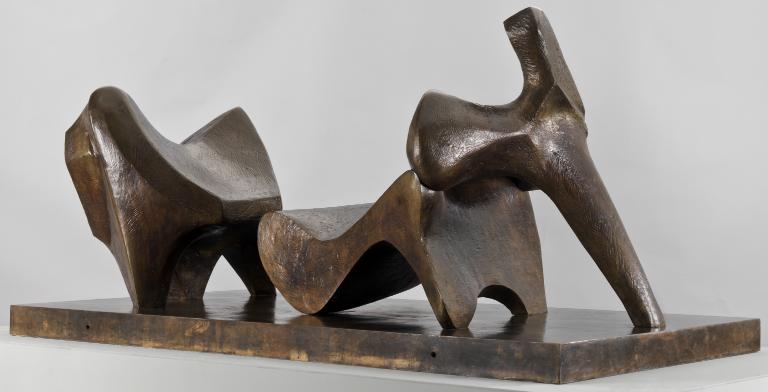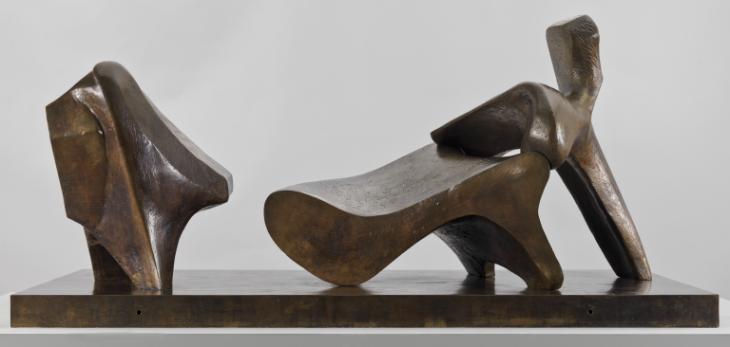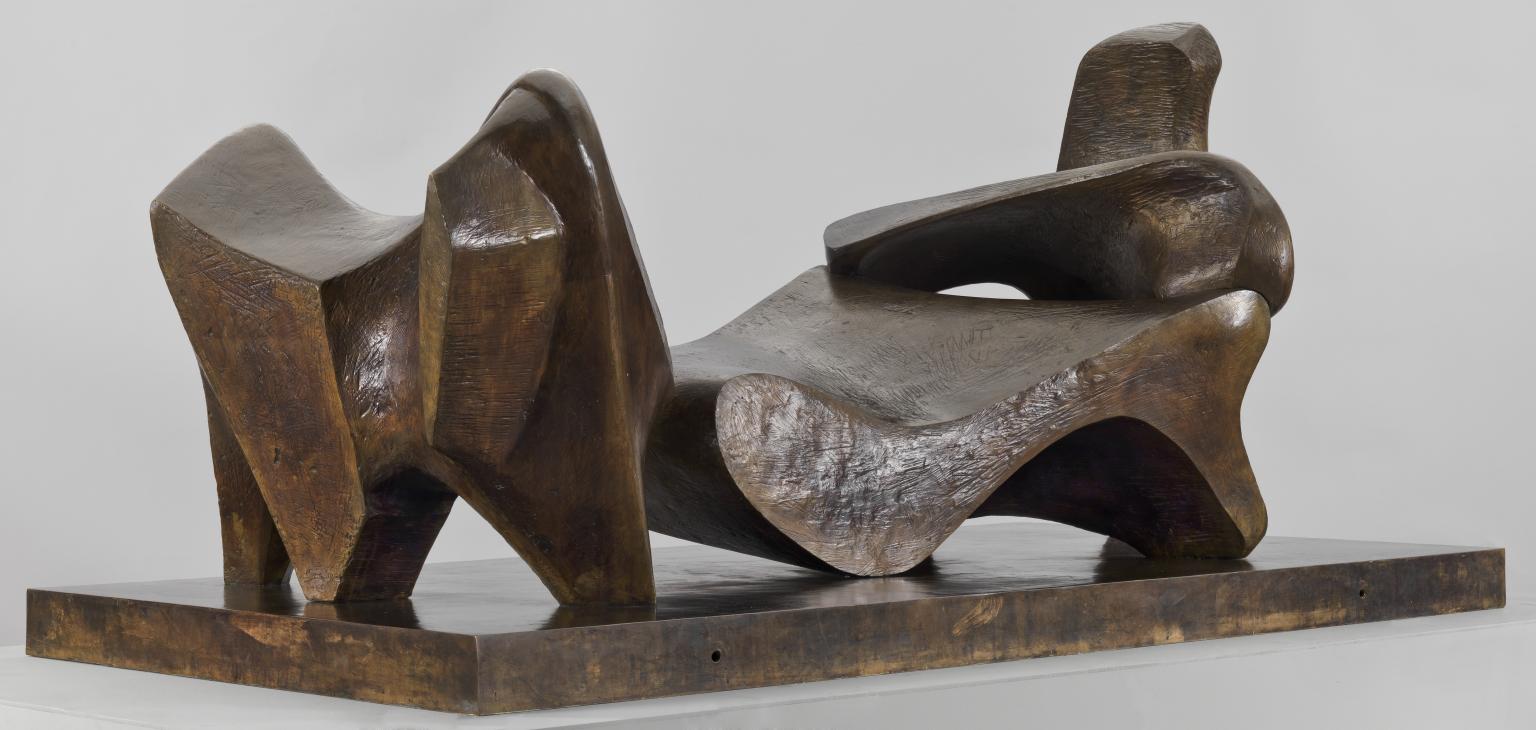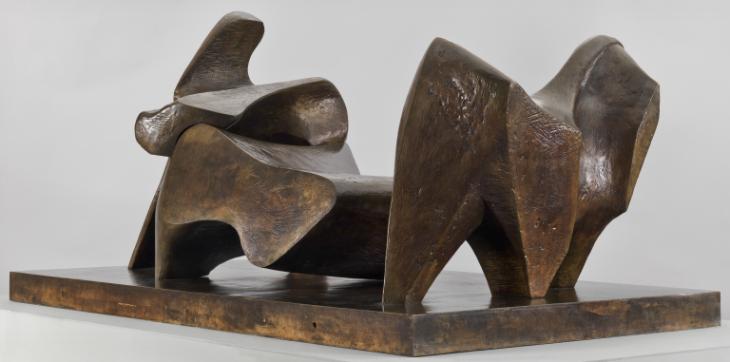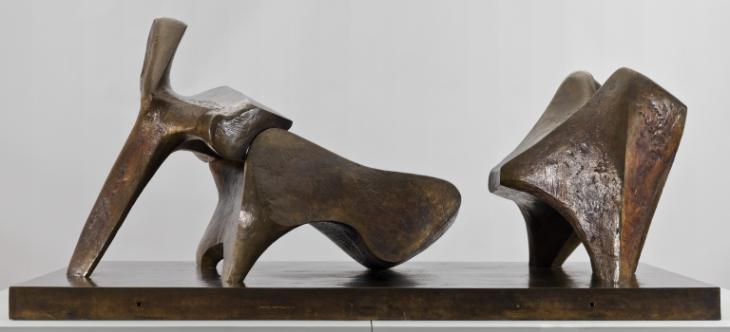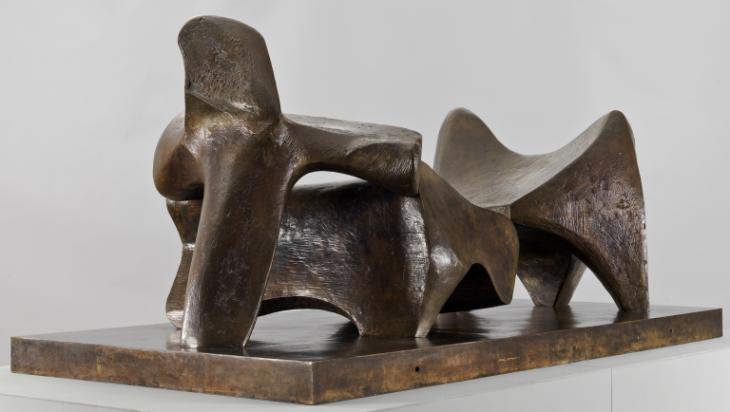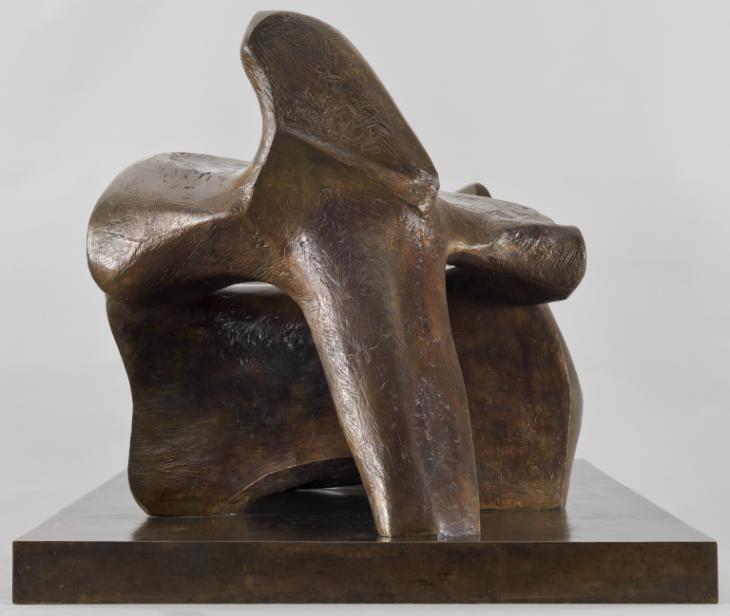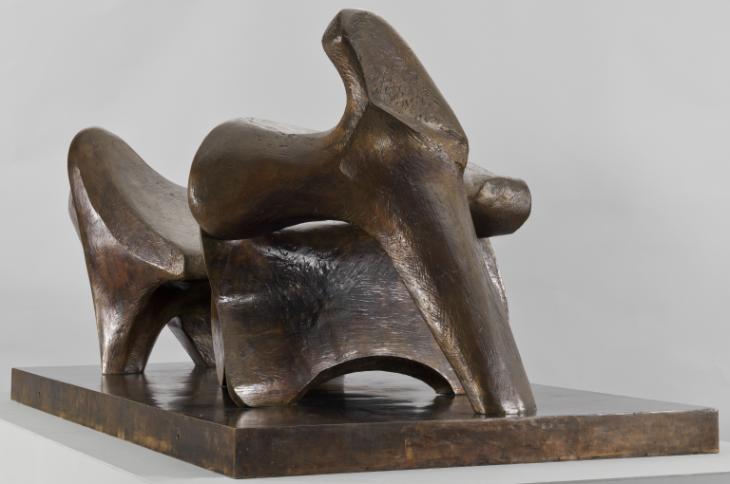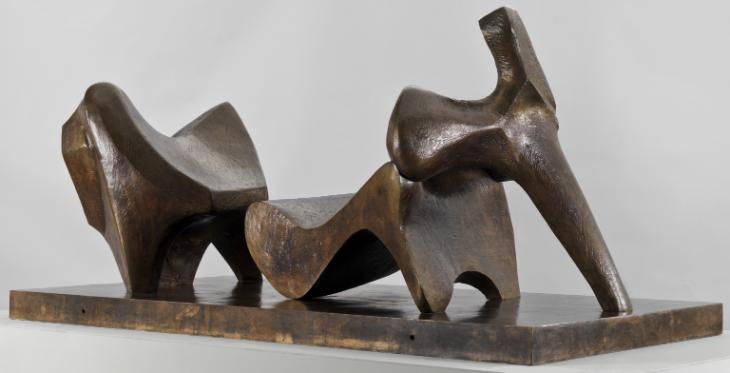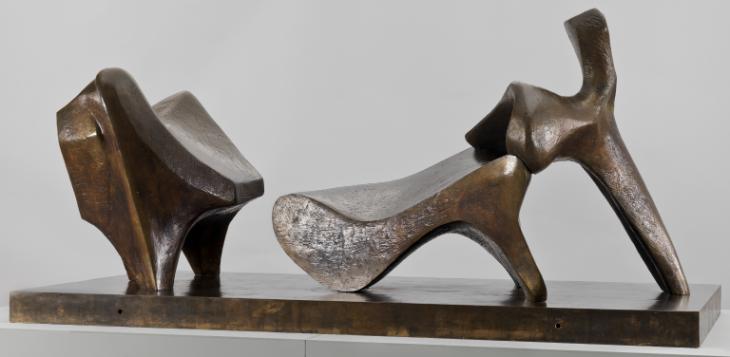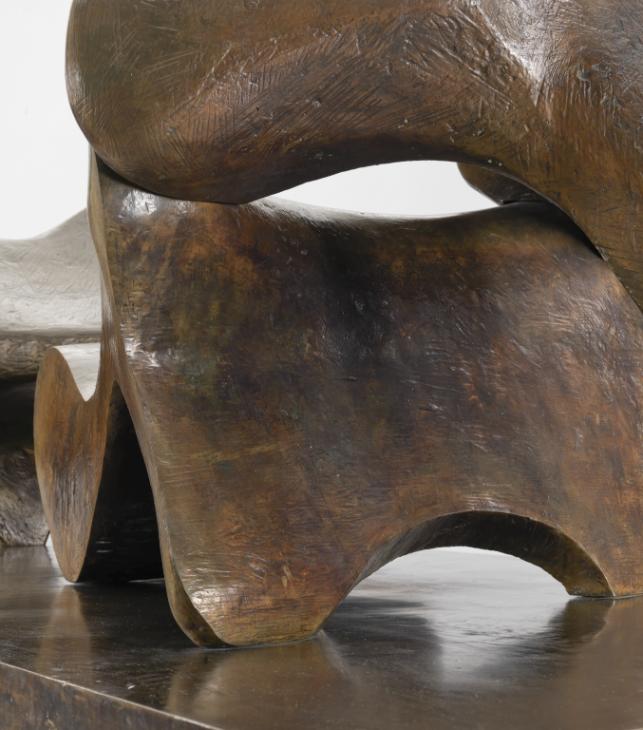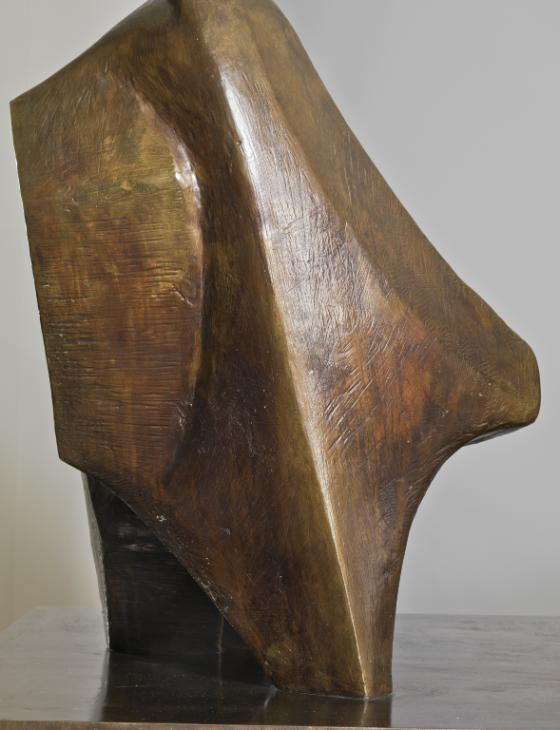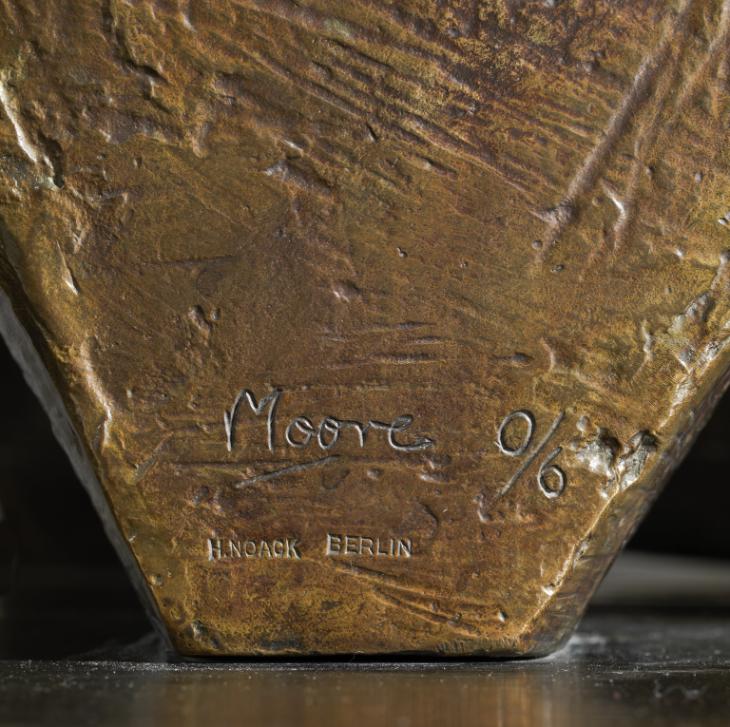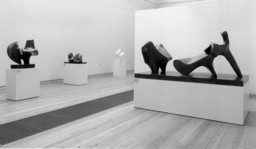Henry Moore OM, CH Three Piece Reclining Figure No.2: Bridge Prop 1963, cast date unknown
Image 1 of 15
-
 Henry Moore OM, CH, Three Piece Reclining Figure No.2: Bridge Prop 1963, cast date unknown© The Henry Moore Foundation. All Rights Reserved© The Henry Moore Foundation. All Rights Reserved
Henry Moore OM, CH, Three Piece Reclining Figure No.2: Bridge Prop 1963, cast date unknown© The Henry Moore Foundation. All Rights Reserved© The Henry Moore Foundation. All Rights Reserved -
 Henry Moore OM, CH, Three Piece Reclining Figure No.2: Bridge Prop 1963, cast date unknown© The Henry Moore Foundation. All Rights Reserved© The Henry Moore Foundation. All Rights Reserved
Henry Moore OM, CH, Three Piece Reclining Figure No.2: Bridge Prop 1963, cast date unknown© The Henry Moore Foundation. All Rights Reserved© The Henry Moore Foundation. All Rights Reserved -
 Henry Moore OM, CH, Three Piece Reclining Figure No.2: Bridge Prop 1963, cast date unknown© The Henry Moore Foundation. All Rights Reserved© The Henry Moore Foundation. All Rights Reserved
Henry Moore OM, CH, Three Piece Reclining Figure No.2: Bridge Prop 1963, cast date unknown© The Henry Moore Foundation. All Rights Reserved© The Henry Moore Foundation. All Rights Reserved -
 Henry Moore OM, CH, Three Piece Reclining Figure No.2: Bridge Prop 1963, cast date unknown© The Henry Moore Foundation. All Rights Reserved© The Henry Moore Foundation. All Rights Reserved
Henry Moore OM, CH, Three Piece Reclining Figure No.2: Bridge Prop 1963, cast date unknown© The Henry Moore Foundation. All Rights Reserved© The Henry Moore Foundation. All Rights Reserved -
 Henry Moore OM, CH, Three Piece Reclining Figure No.2: Bridge Prop 1963, cast date unknown© The Henry Moore Foundation. All Rights Reserved© The Henry Moore Foundation. All Rights Reserved
Henry Moore OM, CH, Three Piece Reclining Figure No.2: Bridge Prop 1963, cast date unknown© The Henry Moore Foundation. All Rights Reserved© The Henry Moore Foundation. All Rights Reserved -
 Henry Moore OM, CH, Three Piece Reclining Figure No.2: Bridge Prop 1963, cast date unknown© The Henry Moore Foundation. All Rights Reserved© The Henry Moore Foundation. All Rights Reserved
Henry Moore OM, CH, Three Piece Reclining Figure No.2: Bridge Prop 1963, cast date unknown© The Henry Moore Foundation. All Rights Reserved© The Henry Moore Foundation. All Rights Reserved -
 Henry Moore OM, CH, Three Piece Reclining Figure No.2: Bridge Prop 1963, cast date unknown© The Henry Moore Foundation. All Rights Reserved© The Henry Moore Foundation. All Rights Reserved
Henry Moore OM, CH, Three Piece Reclining Figure No.2: Bridge Prop 1963, cast date unknown© The Henry Moore Foundation. All Rights Reserved© The Henry Moore Foundation. All Rights Reserved -
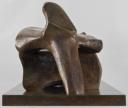 Henry Moore OM, CH, Three Piece Reclining Figure No.2: Bridge Prop 1963, cast date unknown© The Henry Moore Foundation. All Rights Reserved© The Henry Moore Foundation. All Rights Reserved
Henry Moore OM, CH, Three Piece Reclining Figure No.2: Bridge Prop 1963, cast date unknown© The Henry Moore Foundation. All Rights Reserved© The Henry Moore Foundation. All Rights Reserved -
 Henry Moore OM, CH, Three Piece Reclining Figure No.2: Bridge Prop 1963, cast date unknown© The Henry Moore Foundation. All Rights Reserved© The Henry Moore Foundation. All Rights Reserved
Henry Moore OM, CH, Three Piece Reclining Figure No.2: Bridge Prop 1963, cast date unknown© The Henry Moore Foundation. All Rights Reserved© The Henry Moore Foundation. All Rights Reserved -
 Henry Moore OM, CH, Three Piece Reclining Figure No.2: Bridge Prop 1963, cast date unknown© The Henry Moore Foundation. All Rights Reserved© The Henry Moore Foundation. All Rights Reserved
Henry Moore OM, CH, Three Piece Reclining Figure No.2: Bridge Prop 1963, cast date unknown© The Henry Moore Foundation. All Rights Reserved© The Henry Moore Foundation. All Rights Reserved -
 Henry Moore OM, CH, Three Piece Reclining Figure No.2: Bridge Prop 1963, cast date unknown© The Henry Moore Foundation. All Rights Reserved© The Henry Moore Foundation. All Rights Reserved
Henry Moore OM, CH, Three Piece Reclining Figure No.2: Bridge Prop 1963, cast date unknown© The Henry Moore Foundation. All Rights Reserved© The Henry Moore Foundation. All Rights Reserved -
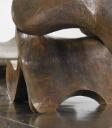 Henry Moore OM, CH, Three Piece Reclining Figure No.2: Bridge Prop 1963, cast date unknown© The Henry Moore Foundation. All Rights Reserved© The Henry Moore Foundation. All Rights Reserved
Henry Moore OM, CH, Three Piece Reclining Figure No.2: Bridge Prop 1963, cast date unknown© The Henry Moore Foundation. All Rights Reserved© The Henry Moore Foundation. All Rights Reserved -
 Henry Moore OM, CH, Three Piece Reclining Figure No.2: Bridge Prop 1963, cast date unknown© The Henry Moore Foundation. All Rights Reserved© The Henry Moore Foundation. All Rights Reserved
Henry Moore OM, CH, Three Piece Reclining Figure No.2: Bridge Prop 1963, cast date unknown© The Henry Moore Foundation. All Rights Reserved© The Henry Moore Foundation. All Rights Reserved -
 Henry Moore OM, CH, Three Piece Reclining Figure No.2: Bridge Prop 1963, cast date unknown© The Henry Moore Foundation. All Rights Reserved© The Henry Moore Foundation. All Rights Reserved
Henry Moore OM, CH, Three Piece Reclining Figure No.2: Bridge Prop 1963, cast date unknown© The Henry Moore Foundation. All Rights Reserved© The Henry Moore Foundation. All Rights Reserved -
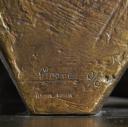 Henry Moore OM, CH, Three Piece Reclining Figure No.2: Bridge Prop 1963, cast date unknown© The Henry Moore Foundation. All Rights Reserved© The Henry Moore Foundation. All Rights Reserved
Henry Moore OM, CH, Three Piece Reclining Figure No.2: Bridge Prop 1963, cast date unknown© The Henry Moore Foundation. All Rights Reserved© The Henry Moore Foundation. All Rights Reserved
© The Henry Moore Foundation. All Rights Reserved
Henry Moore OM, CH,
Three Piece Reclining Figure No.2: Bridge Prop
1963, cast date unknown
© The Henry Moore Foundation. All Rights Reserved
Three Piece Reclining Figure No.2: Bridge Prop 1963 exemplifies how Moore developed and refined his long-standing interest in the subject of the reclining figure in the early 1960s by dividing it into individual parts. However, unlike his earlier multi-part figurative sculptures – the forms of which evoke natural features such as rocks and cliffs – the smooth lines and interconnecting components of this work recall elements of architectural structures.
Henry Moore OM, CH 1898–1986
Three Piece Reclining Figure No.2: Bridge Prop
1963, cast date unknown
Bronze
1049 x 2417 x 1103 mm
Inscribed ‘Moore 0/6’ and ‘H. NOACK BERLIN’ on central foot
Presented by the artist 1978
Artist’s copy aside from edition of 6
T02292
Three Piece Reclining Figure No.2: Bridge Prop
1963, cast date unknown
Bronze
1049 x 2417 x 1103 mm
Inscribed ‘Moore 0/6’ and ‘H. NOACK BERLIN’ on central foot
Presented by the artist 1978
Artist’s copy aside from edition of 6
T02292
Ownership history
Presented by the artist to Tate in 1978 as part of the Henry Moore Gift.
Exhibition history
1965
British Sculpture in the Sixties: An Exhibition Organised by the Contemporary Art Society in Association with the Peter Stuyvesant Foundation, Tate Gallery, London, February–April 1965, no.76.
1969
Henry Moore Exhibition in Japan, 1969, National Museum of Modern Art, Tokyo, August–October 1969, no.58.
1971
Henry Moore 1961–1971, Staatsgalerie Moderner Kunst, Munich, October–November 1971, no.5.
1972
Mostra di Henry Moore, Forte di Belvedere, Florence, May–September 1972, no.127.
1975
Henry Moore: Fem Decennier, Skulptur, Teckning, Grafik 1923–1975, touring exhibition, Henie-Onstad Kunstsenter, Oslo, June–July 1975; Kulturhuset, Stockholm, August–October 1975; Nordjyllands Kunstmuseum, Aalborg, October–November 1975, no.67.
1976
The Work of the British Sculptor Henry Moore, Zürcher Forum, Zürich, June–August 1976, no.73.
1977
Henry Moore: Sculptures et Dessins, Musée de l’Orangerie des Tuileries, Paris, May–August 1977, no.102.
1978
The Henry Moore Gift, Tate Gallery, London, June–August 1978, no number.
1981
Henry Moore: Sculptures, Drawings, Graphics 1921–1981, Palacio de Velázquez, Palacio de Cristal and Parque de El Retiro, Madrid, May–August 1981, no.172.
1981
Henry Moore, Fundacao Calouste Gulbenkian, Lisbon, September–November 1981, no.89.
1981–2
Henry Moore: Exposició Retrospectiva, Escultures, Dibuixos i Gravats 1921–1981, Fundació Joan Miró, Barcelona, December 1981–January 1982, no.89.
1983
Henry Moore: Winchester 1983, Winchester Castle, Winchester, July–September 1983, no number.
References
1963
David Sylvester, ‘Henry Moore Talking: A Conversation with David Sylvester’, Listener, 29 August 1963, pp.305–7.
1963
Henry Moore: Recent Work, exhibition catalogue, Marlborough Fine Art, London 1963, unpaginated (another cast reproduced).
1963
Henry Moore, exhibition catalogue, Art Center in La Jolla, La Jolla 1963 (?another cast reproduced).
1965
Henry Moore, exhibition catalogue, Marlborough Fine Art, London 1965 (another cast reproduced).
1965
Herbert Read, Henry Moore: A Study of his Life and Work, London 1965, p.229–32, reproduced pl.219 and on dustjacket.
1968
David Sylvester, Henry Moore, exhibition catalogue, Tate Gallery, London 1968, pp.93–4 (another cast reproduced pls.50, 132).
1968
Ionel Jianou, Henry Moore, Paris 1968, no.499 (another cast reproduced figs.111–2).
1968
John Russell, Henry Moore, New York 1968, p.187–91, reproduced pl.195.
1968
John Hedgecoe, Henry Moore, London 1968, p.404 (?another cast reproduced).
1970
Henry Moore: Bronzes 1961–70, exhibition catalogue, Marlborough Gallery, New York 1970 (another cast reproduced pp.38–9, no.7).
1970
David Finn and Donald Hall, As The Eye Moves: A Sculpture by Henry Moore, New York 1970 (another cast reproduced).
1970
Robert Melville, Henry Moore: Sculpture and Drawings 1921–1969, London 1970, p.261 (?another cast reproduced pls.651–3).
1973
John Russell, Henry Moore, London 1973 (?another cast reproduced pl.123).
1976
David Finn, Henry Moore: Sculpture and Environment, New York 1976 (other casts reproduced pp.404–9).
1977
Henry Moore: Sculptures et dessins, exhibition catalogue, Musée de l’Orangerie des Tuileries, Paris 1977, reproduced p.80.
1978
Henry Moore: 80th Birthday Exhibition, exhibition catalogue, Cartwright Hall, Bradford 1978 (?another cast reproduced).
1978
The Henry Moore Gift, exhibition catalogue, Tate Gallery, London 1978, reproduced p.47.
1979
Alan G. Wilkinson, The Moore Collection in the Art Gallery of Ontario, Toronto 1979, p.180 (original plaster reproduced pl.162).
1981
The Tate Gallery 1978–80: Illustrated Catalogue of Acquisitions, London 1981, pp.133–4, reproduced p.133.
1981
David Mitchinson (ed.), Henry Moore Sculpture, New York 1981 (another cast reproduced figs.353–4).
1986
Alan Bowness (ed.), Henry Moore. Volume 3: Sculpture and Drawings 1955–64, 1965, revised edn, London 1986, no.513 (?another cast reproduced pls.156–9).
1987
Henry Moore and Landscape, exhibition catalogue, Yorkshire Sculpture Park, West Bretton 1987, p.28, reproduced.
1994
Henry Moore in Bretton Country Park, exhibition catalogue, Bretton Country Park, West Bretton 1994, p.42, reproduced.
2002
Henry Moore: Journey through Form, exhibition catalogue, Tower Gallery, Te Papa 2002 (another cast reproduced no.9).
Technique and condition
This is a large, three-part bronze sculpture of a reclining figure positioned on a rectangular base. Each part of the sculpture is fixed with threaded bolts from underneath the base: two at the end denoting the head, three in the central section, and three at the end denoting the feet. The head section rests on the central section but there is no evidence of a join (fig.1). Two holes on each of the long sides of the base accommodate specialist eye bolts that allow the sculpture to be safely lifted into position (fig.2).
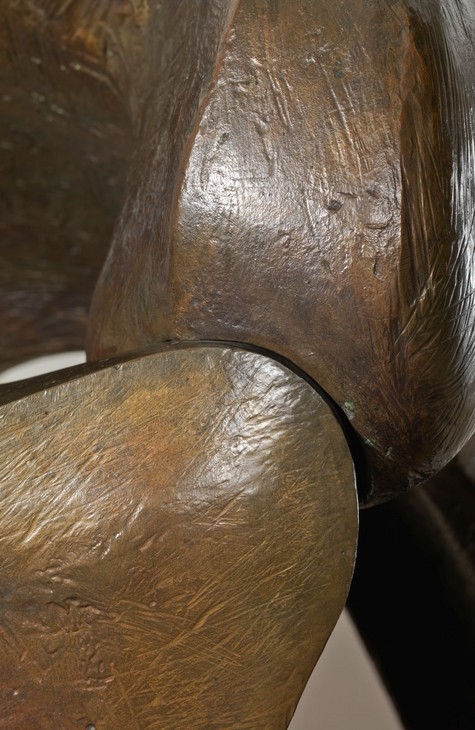
Detail of interlocking pieces of Three Piece Reclining Figure No.2: Bridge Prop 1963, cast date unknown
Tate T02292
© The Henry Moore Foundation. All Rights Reserved
Fig.1
Detail of interlocking pieces of Three Piece Reclining Figure No.2: Bridge Prop 1963, cast date unknown
Tate T02292
© The Henry Moore Foundation. All Rights Reserved
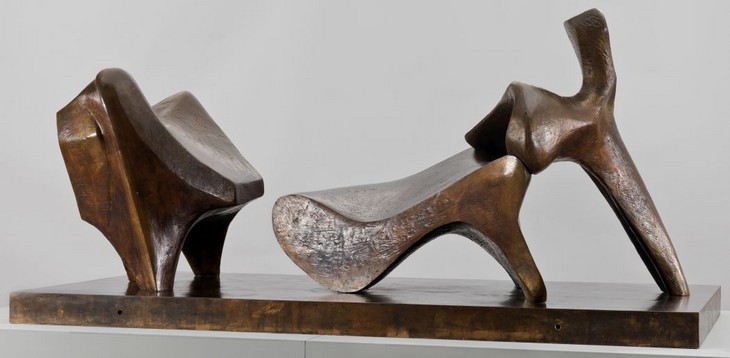
Henry Moore
Three Piece Reclining Figure No.2: Bridge Prop 1963, cast date unknown (side view)
Tate T02292
© The Henry Moore Foundation. All Rights Reserved
Fig.2
Henry Moore
Three Piece Reclining Figure No.2: Bridge Prop 1963, cast date unknown (side view)
Tate T02292
© The Henry Moore Foundation. All Rights Reserved
Moore would have made the original model for this sculpture by building up successive layers of wet plaster over a supportive armature, probably made using a combination of lengths of wood and scrim bandage. Close examination of the surface shows how Moore carefully created the smooth surface texture by using a range of implements from fine pointed tools to surforms or graters. On the head section a more craggy texture has been achieved by making deep gouges in the plaster.
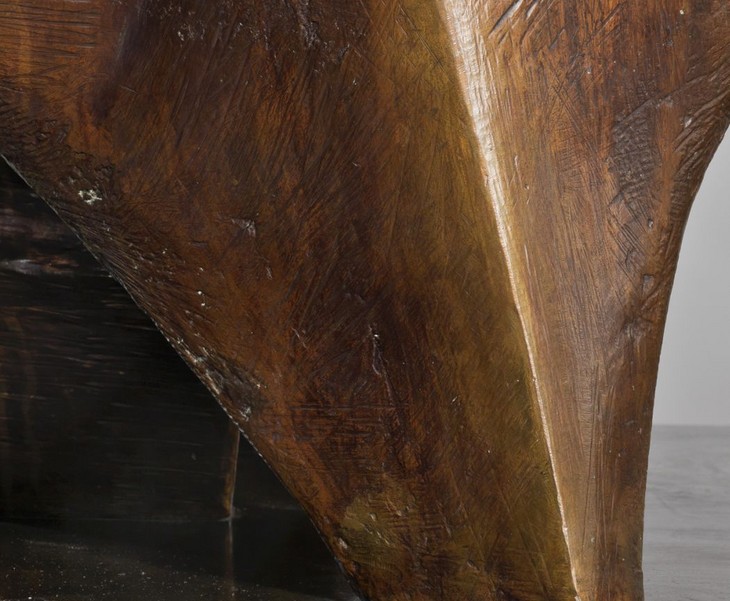
Detail of casting investment on Three Piece Reclining Figure No.2: Bridge Prop 1963, cast date unknown
Tate T02292
© The Henry Moore Foundation. All Rights Reserved
Fig.3
Detail of casting investment on Three Piece Reclining Figure No.2: Bridge Prop 1963, cast date unknown
Tate T02292
© The Henry Moore Foundation. All Rights Reserved
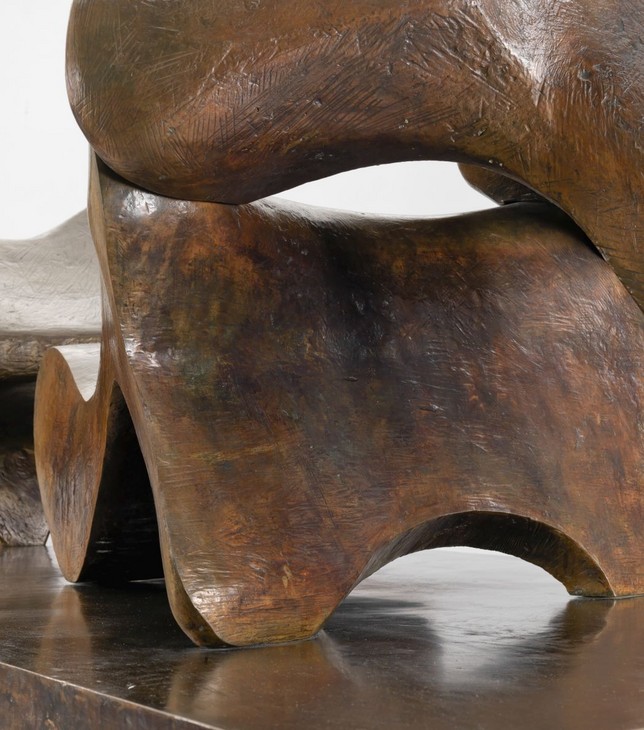
Detail of patina on Three Piece Reclining Figure No.2: Bridge Prop 1963, cast date unknown
Tate T02292
© The Henry Moore Foundation. All Rights Reserved
Fig.4
Detail of patina on Three Piece Reclining Figure No.2: Bridge Prop 1963, cast date unknown
Tate T02292
© The Henry Moore Foundation. All Rights Reserved
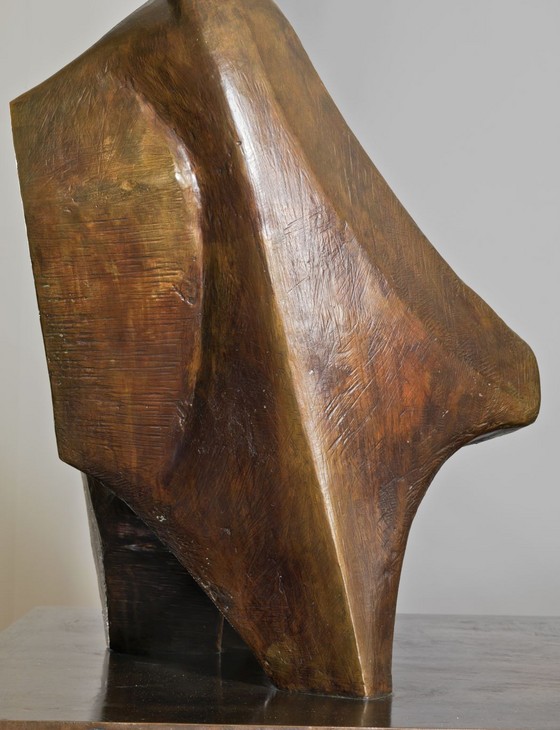
Detail of patina on Three Piece Reclining Figure No.2: Bridge Prop 1963, cast date unknown
Tate T02292
© The Henry Moore Foundation. All Rights Reserved
Fig.5
Detail of patina on Three Piece Reclining Figure No.2: Bridge Prop 1963, cast date unknown
Tate T02292
© The Henry Moore Foundation. All Rights Reserved
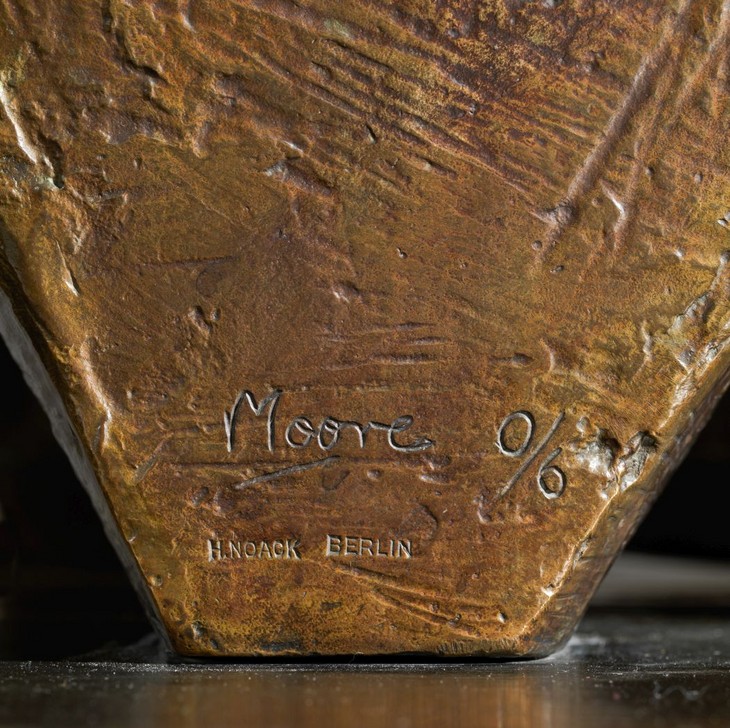
Detail of artist's signature, edition number and foundry stamp on Three Piece Reclining Figure No.2: Bridge Prop 1963, cast date unknown
Tate T02292
© The Henry Moore Foundation. All Rights Reserved
Fig.6
Detail of artist's signature, edition number and foundry stamp on Three Piece Reclining Figure No.2: Bridge Prop 1963, cast date unknown
Tate T02292
© The Henry Moore Foundation. All Rights Reserved
The finished sculpture was artificially patinated to colour the surface and to help disguise welds and repairs. This process involved applying chemical solutions to the bronze that reacted with the metal to create coloured compounds. In this case the patina on both the sculpture and the base is a dark, variegated brown with reddish brown and dark green accents (figs.4 and 5), an effect that was probably achieved by applying at least three different chemical solutions in varying concentrations.
The artist’s signature and edition number ‘Moore 0/6’, along with the founder’s mark ‘H.NOACK BERLIN’, are visible on the central foot close to where it meets the base (fig.6).
Lyndsey Morgan
March 2013
How to cite
Lyndsey Morgan, 'Technique and Condition', March 2013, in Alice Correia, ‘Three Piece Reclining Figure No.2: Bridge Prop 1963, cast date unknown by Henry Moore OM, CH’, catalogue entry, March 2014, in Henry Moore: Sculptural Process and Public Identity, Tate Research Publication, 2015, https://wwwEntry
Three Piece Reclining Figure No.2: Bridge Prop was made in 1963 and comprises three separate bronze segments positioned on a bronze base that together may be understood to represent a reclining human figure. The tallest section appears to represent a head and neck, implying that the smaller central section represents a torso, while the third section in the arrangement occupies the position of the figure’s legs. Although the gender of the figure is unspecified, Moore’s multi-piece reclining figures are usually regarded as female. This sculpture is the second in a series of three-piece works created during the 1960s, and is closely related to the earlier Three Piece Reclining Figure No.1 1961–2 (Tate T02289).
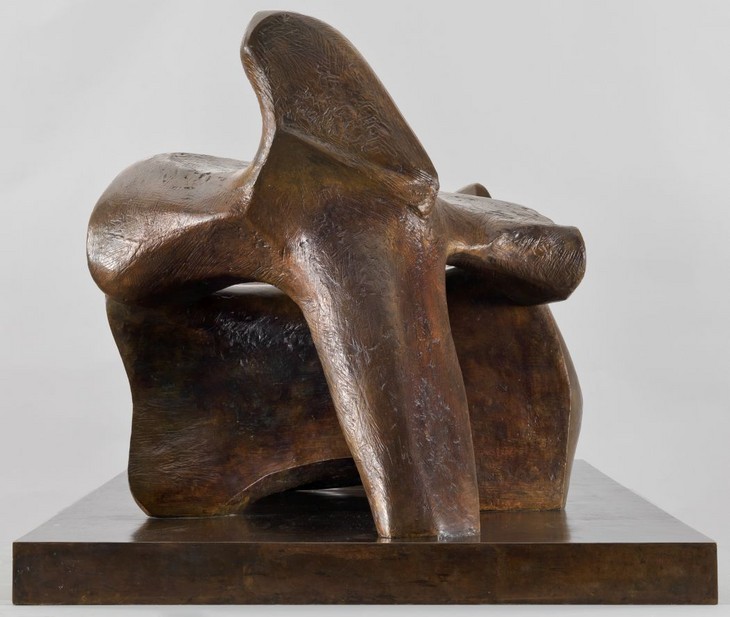
Detail of head section of Three Piece Reclining Figure No.2: Bridge Prop 1963, cast date unknown
Tate T02292
© The Henry Moore Foundation. All Rights Reserved
Fig.1
Detail of head section of Three Piece Reclining Figure No.2: Bridge Prop 1963, cast date unknown
Tate T02292
© The Henry Moore Foundation. All Rights Reserved
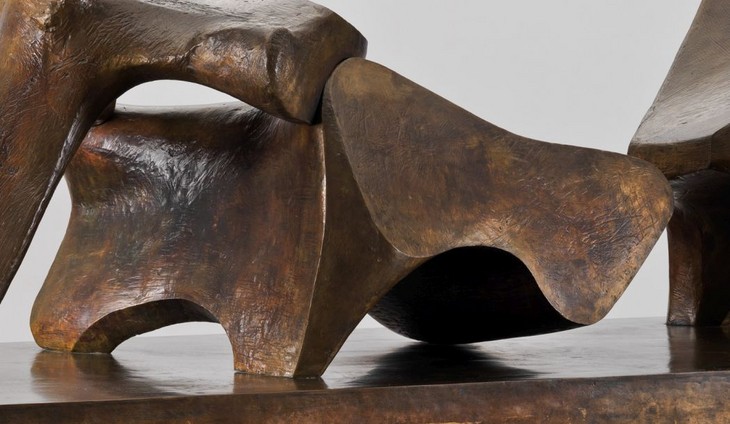
Detail of central section of Three Piece Reclining Figure No.2: Bridge Prop 1963, cast date unknown
Tate T02292
© The Henry Moore Foundation. All Rights Reserved
Fig.2
Detail of central section of Three Piece Reclining Figure No.2: Bridge Prop 1963, cast date unknown
Tate T02292
© The Henry Moore Foundation. All Rights Reserved
The head of the figure does not possess any naturalistic facial features but can be recognized due to its position within the composition. It is denoted by a thin, flat shape that protrudes upwards at an angle from a diagonally orientated tubular column representing the spine, which rests on the base (fig.1). A rounded, shelf-like form, which could be shoulders, breasts or the sternum, extends horizontally towards the central section of the sculpture on which it rests, balancing at two points. The central piece is the shortest in height of the three sections but the longest in length (fig.2). Two short appendages separated by a shallow arch support one end of a thick upper surface that curves downwards elegantly from the shoulders towards the base, creating an arch underneath. At the point where it meets the base this upper surface expands in thickness before rising back upwards to create a tilted, concave top that aligns neatly with the leg section. This piece also rests on the base at three points that rise upwards to two peaks, which may be understood as knees (fig.3). In between the supporting legs are two triangular arches that seem to echo the trough carved out between the knees above and which, like the head, appear to lean towards one side.
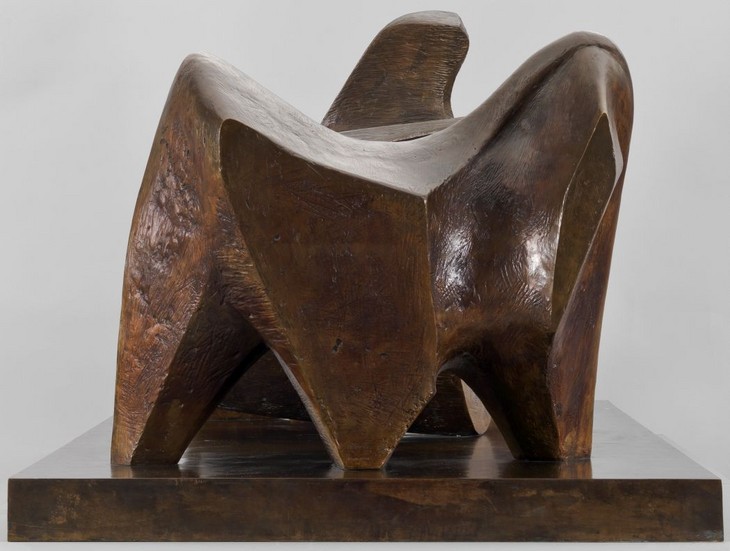
Detail of leg section of Three Piece Reclining Figure No.2: Bridge Prop 1963, cast date unknown
Tate T02292
© The Henry Moore Foundation. All Rights Reserved
Fig.3
Detail of leg section of Three Piece Reclining Figure No.2: Bridge Prop 1963, cast date unknown
Tate T02292
© The Henry Moore Foundation. All Rights Reserved

Henry Moore
Three Piece Reclining Figure No.2: Bridge Prop 1963, cast date unknown (side view)
Tate T02292
© The Henry Moore Foundation. All Rights Reserved
Fig.4
Henry Moore
Three Piece Reclining Figure No.2: Bridge Prop 1963, cast date unknown (side view)
Tate T02292
© The Henry Moore Foundation. All Rights Reserved
When seen from the side, a truncated protrusion appears to jut out from behind the knees towards the central piece, accentuating the gap between these two parts (fig.4). However, from the same viewpoint it is evident that all of the pieces appear to lean forwards at a diagonal angle, unifying the individual parts in a collective directional pull. The pieces are also connected by the sweep of a continuous curved line that can be traced along the length of the figure from the head to the knee, bridging the gaps between each section.
From plaster to bronze
Moore developed his ideas for his three-piece sculptures with a series of small maquettes. By the early 1960s Moore had moved away from making preliminary drawings for his sculptures and had started making small three-dimensional models in plaster and other malleable materials. It is probable that he made the maquette for Three Piece Reclining Figure No.2: Bridge Prop in the maquette studio on the grounds of his home, Hoglands, at Perry Green in Hertfordshire. This studio was lined with shelves displaying Moore’s ever growing collection of found bones, shells and flint stones, the shapes of which often served as starting points for Moore’s formal experiments in three dimensions. In 1967 Moore explained, ‘when I study a bone, I look for its human implications. Taste is not the guide. I’m not interested in the niceties of a shape’.1 A few years earlier Moore had explained to the critic David Sylvester how exactly he worked with these natural objects:
I look at them, handle them, see them from all round, and I may press them into clay and pour plaster into that clay and get a start as a bit of plaster, which is a reproduction of the object. And then add to it, change it. In that sort of way something turns out in the end that you could never have thought of the day before.2
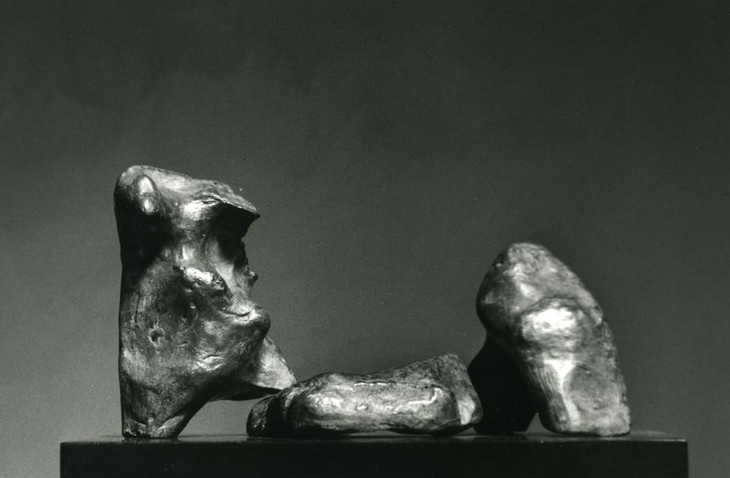
Henry Moore
Three Piece Reclining Figure: Maquette No.1 1961
Bronze
© The Henry Moore Foundation. All Rights Reserved
Fig.5
Henry Moore
Three Piece Reclining Figure: Maquette No.1 1961
© The Henry Moore Foundation. All Rights Reserved
Sometimes I make ten or twenty maquettes for every one that I use in a large scale – the others may get rejected. If a maquette keeps its interest enough for me to want to realise it as a full-size final work, then I might make a working model in an intermediate size, in which changes will be made before going to the real, full-sized sculpture. Changes get made at all these stages.4
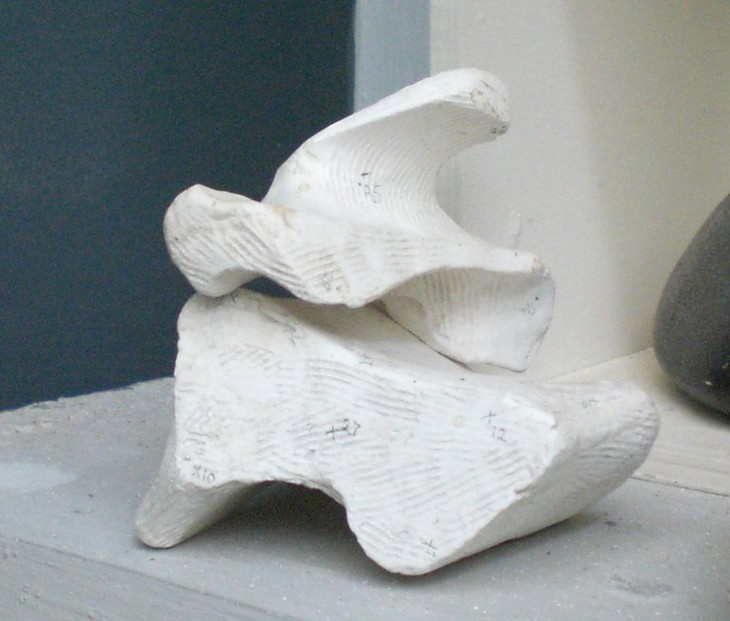
Fragments of plaster maquette for Three Piece Reclining Figure No.2: Bridge Prop 1963
The Henry Moore Foundation
© The Henry Moore Foundation. All Rights Reserved
Fig.6
Fragments of plaster maquette for Three Piece Reclining Figure No.2: Bridge Prop 1963
The Henry Moore Foundation
© The Henry Moore Foundation. All Rights Reserved
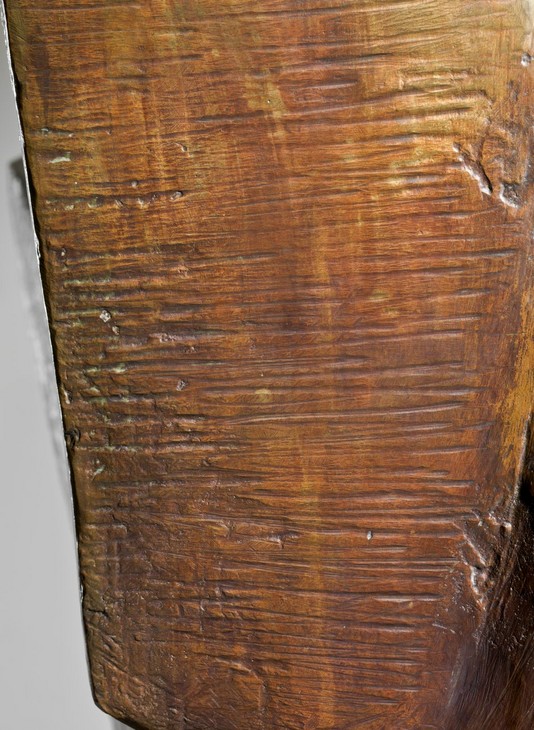
Detail of surface texture on leg section of Three Piece Reclining Figure No.2: Bridge Prop 1963, cast date unknown
Tate T02289
© The Henry Moore Foundation. All Rights Reserved
Fig.7
Detail of surface texture on leg section of Three Piece Reclining Figure No.2: Bridge Prop 1963, cast date unknown
Tate T02289
© The Henry Moore Foundation. All Rights Reserved

Detail of artist's signature, edition number and foundry stamp on Three Piece Reclining Figure No.2: Bridge Prop 1963, cast date unknown
Tate T02292
© The Henry Moore Foundation. All Rights Reserved
Fig.8
Detail of artist's signature, edition number and foundry stamp on Three Piece Reclining Figure No.2: Bridge Prop 1963, cast date unknown
Tate T02292
© The Henry Moore Foundation. All Rights Reserved
The level of detail on Tate’s bronze copy of Three Piece Reclining Figure No.2: Bridge Prop suggests that it was cast using the lost wax technique, which would have required the full-size plaster version to be carved up into smaller pieces so that moulds could be created of each piece. The inside of each mould would have been ‘greased’ with a releasing agent before molten wax was poured into it. Once the wax had hardened it could be released from the mould, forming an exact replica of the sculpture in wax. The wax would then be encased in a hard refractory material, placed in a kiln and heated until it melted. Channels within the casing would allow the wax to drain away and, once empty, the cavity was filled with molten bronze. After the bronze had hardened the casing could be removed, revealing the section of sculpture. Once all the pieces of the sculpture had been cast in this way they would be welded together. Finally, the casting seams would have been filed down so that the joins between each section were practically imperceptible.

Detail of patina on Three Piece Reclining Figure No.2: Bridge Prop 1963, cast date unknown
Tate T02292
© The Henry Moore Foundation. All Rights Reserved
Fig.9
Detail of patina on Three Piece Reclining Figure No.2: Bridge Prop 1963, cast date unknown
Tate T02292
© The Henry Moore Foundation. All Rights Reserved
Sources and development
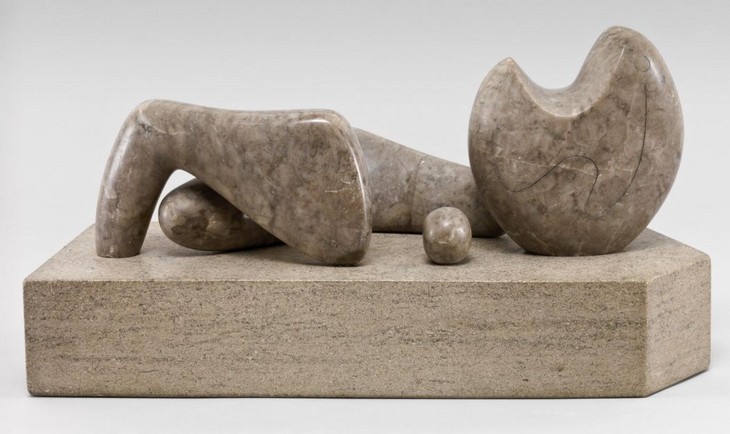
Henry Moore
Four-Piece Composition: Reclining Figure 1934
Cumberland alabaster on a Purbeck marble base
175 x 457 x 203 mm
Tate T02054
© The Henry Moore Foundation. All Rights Reserved
Fig.10
Henry Moore
Four-Piece Composition: Reclining Figure 1934
Tate T02054
© The Henry Moore Foundation. All Rights Reserved
The two-piece sculptures pose a problem like the kind of relationship between two people. And it’s very different once you divide a thing into three: then you have two ends and a middle. In the two-piece you have just the head end and the body end or the head end and the leg end, but once you get the three-piece you have the middle and the two ends, and this became something that I wanted to do ... three is enough to make the difference from two. That is what one tried to make: it is a connecting-piece carrying through from one end to the other like you might have with a snake.12
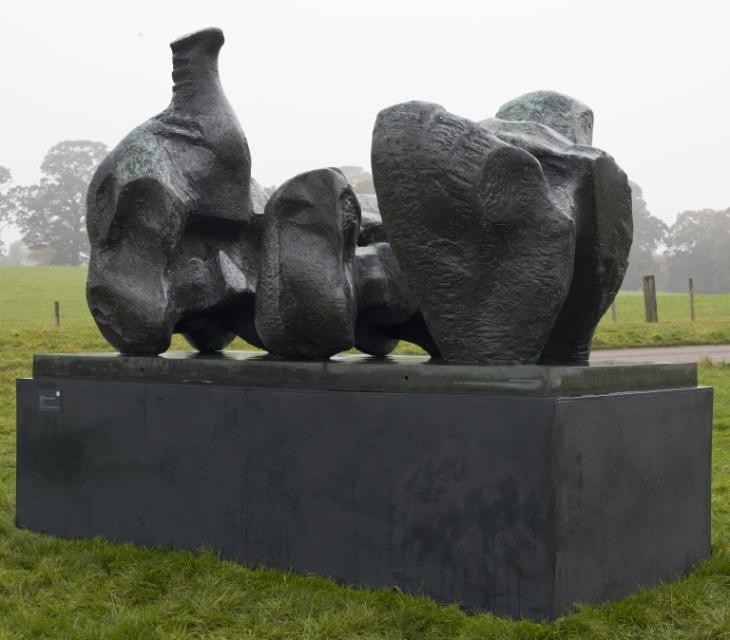
Henry Moore
Three-Piece Reclining Figure No.1 1961–2, cast date unknown
Tate T02289
© The Henry Moore Foundation. All Rights Reserved
Fig.11
Henry Moore
Three-Piece Reclining Figure No.1 1961–2, cast date unknown
Tate T02289
© The Henry Moore Foundation. All Rights Reserved

Detail of interlocking pieces of Three Piece Reclining Figure No.2: Bridge Prop 1963, cast date unknown
Tate T02292
© The Henry Moore Foundation. All Rights Reserved
Fig.12
Detail of interlocking pieces of Three Piece Reclining Figure No.2: Bridge Prop 1963, cast date unknown
Tate T02292
© The Henry Moore Foundation. All Rights Reserved
Moore made his first three-piece reclining figure in 1961–2 (fig.11). In this work, each of the three pieces are spaced apart from each other at equal intervals, whereas in Three Piece Reclining Figure No.2: Bridge Prop the head section leans on the central section (fig.12) while the legs stand alone at the other end of the composition. Importantly, the head and central sections actually interlock in a way that is reminiscent of shoulder or hip joints. Writing in 1968, the critic Donald Hall noted this feature of the work:
The pieces touch, and could have been cast together, but are actually separate, and the sense of leaning is enormously salient. The head part, or Prop, leans on the Bridge, and one feels the pressure, yet one knows that the Bridge will never move under this pressure. The elegance and restraint of the head, its lightness, creates a repose which equals the pressure of leaning. The foot part leans away, in the same direction as the Prop, but is brought to rest by the counter-prop of a middle leg. The sculpture is a system of improvised resolutions, and it is never merely symmetrical.13
It is probable that while making this work Moore was looking at bone fragments and thinking about how skeletons are made up of multiple interlocking units. This interest in interconnecting parts was developed further in Locking Piece 1963–4 (Tate T02293).
Three Piece Reclining Figure No.2: Bridge Prop is one of Moore’s most complex representations of the reclining figure, a subject that preoccupied him throughout his career. In 1968 Moore reflected on the centrality of the reclining figure to his work, suggesting that the motif offered opportunities to experiment with form:
I want to be quite free of having to find a ‘reason’ for doing the Reclining Figures, and freer still of having to find a ‘meaning’ for them. The vital thing for an artist is to have a subject that allows [him] to try out all kinds of formal ideas – things that he doesn’t yet know about for certain but wants to experiment with, as Cézanne did in this ‘Bathers’ series. In my case the reclining figure provides chances of that sort. The subject-matter is given. It’s settled for you, and you know it and like it, so that within it, within the subject that you’ve done a dozen times before, you are free to invent a completely new form-idea.14
In a manner comparable to Cézanne’s representation of mass and volume, Moore’s distillation of the human body into forms of various size and shape allowed him stretch the boundaries of his sculptural vocabulary while retaining a commitment to figurative art.
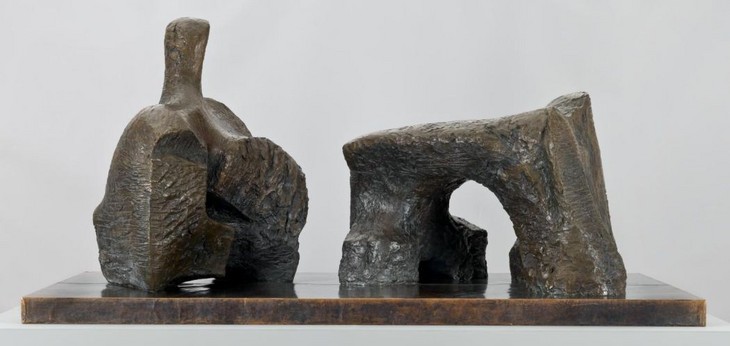
Henry Moore
Two Piece Reclining Figure No.2 1960, cast 1961–2
Tate T00395
© The Henry Moore Foundation. All Rights Reserved
Fig.13
Henry Moore
Two Piece Reclining Figure No.2 1960, cast 1961–2
Tate T00395
© The Henry Moore Foundation. All Rights Reserved
Its name, like so many of the titles I give to my sculptures is descriptive ... The words Bridge and Prop came about because if one looks at the sculpture, with its base at eye level, then it makes a series of arches, or bridges (it reminded me while doing it of the views underneath Waterloo Bridge from the embankment, which I often pass when taking a taxi from Liverpool Street Station to the West End). Prop applies to the arm that props up the head and shoulder part against the middle piece – and the two words just got joined together, and became Bridge-Prop.19
Critical reception
A cast of Three Piece Reclining Figure No.2: Bridge Prop was exhibited at Moore’s commercial gallery, Marlborough Fine Art, at its premises in London in July 1965 as part of a two-person exhibition that Moore shared with the painter Francis Bacon. An unnamed critic reviewing the show for the Times stated that the ‘the art of Mr Moore continues in its pace of unhurried majesty’.20 The term majesty was also used by the critic G.S. Whittet, who wrote in the art magazine Studio International that he was struck by ‘the strength of his imagery and his full majesty of those forms that create presences of themselves’.21 Writing in the Spectator magazine, Bryan Robertson, curator at the Whitechapel Gallery, noted that, ‘Moore’s invincible sense of human resilience ... is sometimes frozen into hard, wary monumentality as in the recent Bridge Prop reclining figure, but his surrealist instinct makes it hard to tell hot from cold, flesh from bone, helmet or shell from leathery skin’.22
The cast of Three Piece Reclining Figure No.2: Bridge Prop belonging to the Leeds City Art Gallery was included in Moore’s retrospective exhibition held at the Tate Gallery in 1968. In an extended review of the show, the sculptor William Tucker suggested that the horizontality of Moore’s reclining figures such as Three Piece Reclining Figure No.2: Bridge Prop, which illustrated the review, allowed younger sculptors such as Anthony Caro to develop and open up the horizontal plane in new ways, arguing that ‘Moore’s re-discovery or at least re-affirmation for modern art of the horizontal axis has been his most fruitful contribution’.23
In 1970 the photographer and collector David Finn collaborated with the critic Donald Hall on a book dedicated to Three Piece Reclining Figure No.2: Bridge Prop called As the Eye Moves... A Sculpture by Henry Moore, in which 150 photographs taken by Finn of cast number six of the sculpture are accompanied by texts by Hall and Moore. The photographs examine the sculpture from different angles and were taken at different times of day, at different times of the year, and in different lighting conditions. In his foreword to the book Moore noted that:
I have always found photographic sculpture difficult ... I suggested that David Finn might publish a book of his photographs of this one piece, so that anyone who studied all the photographs together, might learn how the various forms of a piece of sculpture can fit together. Some of these pictures are so different that one can scarcely believe that they are taken of the same piece of sculpture ... The single work seems to be many.24
The Henry Moore Gift
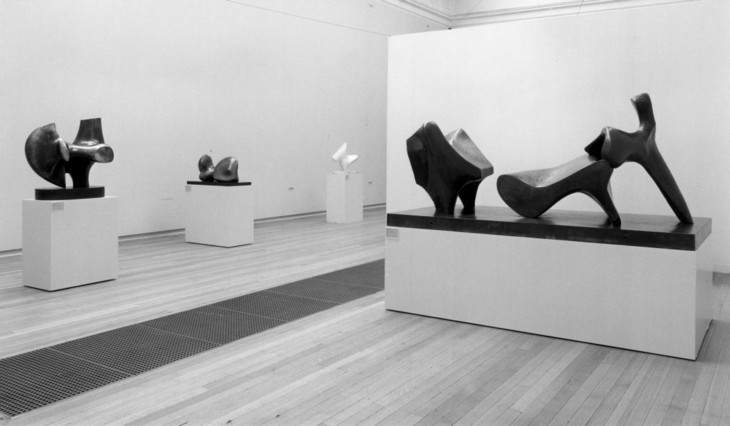
Three Piece Reclining Figure No.2: Bridge Prop installed in the Tate Gallery in 1978
Tate T02292
© The Henry Moore Foundation. All Rights Reserved
Fig.14
Three Piece Reclining Figure No.2: Bridge Prop installed in the Tate Gallery in 1978
Tate T02292
© The Henry Moore Foundation. All Rights Reserved
The other casts of Three Piece Reclining Figure No.2: Bridge Prop can be found in the collections of the Leeds City Art Gallery, the David Winton Bell Gallery at Brown University, Providence, and the Hirshhorn Museum and Sculpture Garden, Washington D.C. Moore’s original plaster is held in the Art Gallery of Ontario, Toronto. Cast number three of the edition was sold at Sotheby’s to a private collector in February 2012 for £3,289,250.28
Alice Correia
March 2014
Notes
Albert Elsen, ‘Henry Moore’s Reflections on Sculpture’, Art Journal, vol.26, no.4, Summer 1967, p.355.
Henry Moore cited in ‘Henry Moore Talking to David Sylvester’, 7 June 1963, transcript of Third Programme, BBC Radio, broadcast 14 July 1963, p.18 Tate Archive TGA 200816. (An edited version of this interview was published in Listener, 29 August 1963, pp.305–7).
Henry Moore cited in Mervyn Levy, ‘Henry Moore: Sculpture Against the Sky’, Studio International, vol.167, no.853, May 1964, p.179.
Henry Moore cited in Donald Hall, ‘Henry Moore: An Interview by Donald Hall’, Horizon, November 1960, reprinted in Alan Wilkinson (ed.), Henry Moore: Writings and Conversations, Aldershot 2002, p.226.
For information on Corinthian Bronze Co. Ltd see ‘British Bronze Sculpture Founders and Plaster Figure Makers, 1800–1980’, http://www.npg.org.uk/research/programmes/british-bronze-founders-and-plaster-figure-makers-1800-1980-1/british-bronze-founders-and-plaster-figure-makers-1800-1980-c.php , accessed 5 August 2013.
Donald Hall, ‘Foreword’, in David Finn and Donald Hall, As the Eye Moves... A Sculpture by Henry Moore, New York 1970, p.17.
See Alice Correia, ‘Two Piece Reclining Figure No.2 1960, cast 1961–2 by Henry Moore OM, CH’, catalogue entry, in Henry Moore: Sculptural Process and Public Identity, 2015, https://www.tate.org.uk/art/research/content/1171982?project=4, accessed 21 April 2015.
G.S. Whittet, ‘Farewell to Flat, Goodbye to Square: London Commentary’, Studio International, October 1965, pp.169.
These figures are based on those listed in a memo in the exhibition’s records; see Tate Public Records TG 92/344/2.
Impressionist & Modern Art Evening Sale, sales catalogue, Sotheby’s, London, 8 February 2012, lot 33, http://www.sothebys.com/en/auctions/ecatalogue/2012/impressionist-modernt-art-evening-sale-l12002/lot.33.html , accessed 5 August 2013.
Related essays
- Henry Moore: The Plasters Anita Feldman
- Henry Moore's Approach to Bronze Lyndsey Morgan and Rozemarijn van der Molen
Related material
-
Photograph
Related reviews and articles
- William Tucker, ‘Moore at the Tate’ Studio International, vol.176, no. 904, October 1968, p.124.
How to cite
Alice Correia, ‘Three Piece Reclining Figure No.2: Bridge Prop 1963, cast date unknown by Henry Moore OM, CH’, catalogue entry, March 2014, in Henry Moore: Sculptural Process and Public Identity, Tate Research Publication, 2015, https://www

